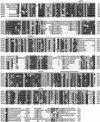Molecular characterization of a novel gene family encoding ACT domain repeat proteins in Arabidopsis
- PMID: 12481063
- PMCID: PMC166691
- DOI: 10.1104/pp.007484
Molecular characterization of a novel gene family encoding ACT domain repeat proteins in Arabidopsis
Abstract
In bacteria, the regulatory ACT domains serve as amino acid-binding sites in some feedback-regulated amino acid metabolic enzymes. We have identified a novel type of ACT domain-containing protein family in Arabidopsis whose members contain ACT domain repeats (the "ACR" protein family). There are at least eight ACR genes located on each of the five chromosomes in the Arabidopsis genome. Gene structure comparisons indicate that the ACR gene family may have arisen by gene duplications. Northern-blot analysis indicates that each member of the ACR gene family has a distinct expression pattern in various organs from 6-week-old Arabidopsis. Moreover, analyses of an ACR3 promoter-beta-glucuronidase (GUS) fusion in transgenic Arabidopsis revealed that the GUS activity formed a gradient in the developing leaves and sepals, whereas low or no GUS activity was detected in the basal regions. In 2-week-old Arabidopsis seedlings grown in tissue culture, the expression of the ACR gene family is differentially regulated by plant hormones, salt stress, cold stress, and light/dark treatment. The steady-state levels of ACR8 mRNA are dramatically increased by treatment with abscisic acid or salt. Levels of ACR3 and ACR4 mRNA are increased by treatment with benzyladenine. The amino acid sequences of Arabidopsis ACR proteins are most similar in the ACT domains to the bacterial sensor protein GlnD. The ACR proteins may function as novel regulatory or sensor proteins in plants.
Figures








Similar articles
-
The ACR11 encodes a novel type of chloroplastic ACT domain repeat protein that is coordinately expressed with GLN2 in Arabidopsis.BMC Plant Biol. 2011 Aug 24;11:118. doi: 10.1186/1471-2229-11-118. BMC Plant Biol. 2011. PMID: 21861936 Free PMC article.
-
Expression of an Arabidopsis phosphoglycerate mutase homologue is localized to apical meristems, regulated by hormones, and induced by sedentary plant-parasitic nematodes.Plant Mol Biol. 2003 Nov;53(4):513-30. doi: 10.1023/B:PLAN.0000019062.80459.80. Plant Mol Biol. 2003. PMID: 15010616
-
Characterization of the expression of a desiccation-responsive rd29 gene of Arabidopsis thaliana and analysis of its promoter in transgenic plants.Mol Gen Genet. 1993 Jan;236(2-3):331-40. doi: 10.1007/BF00277130. Mol Gen Genet. 1993. PMID: 8437577
-
Identification of pathogen-responsive regions in the promoter of a pepper lipid transfer protein gene (CALTPI) and the enhanced resistance of the CALTPI transgenic Arabidopsis against pathogen and environmental stresses.Planta. 2005 Jun;221(3):361-73. doi: 10.1007/s00425-004-1461-9. Epub 2005 Jan 15. Planta. 2005. PMID: 15654638
-
Copines: a ubiquitous family of Ca(2+)-dependent phospholipid-binding proteins.Cell Mol Life Sci. 2002 Sep;59(9):1467-77. doi: 10.1007/s00018-002-8522-7. Cell Mol Life Sci. 2002. PMID: 12440769 Free PMC article. Review.
Cited by
-
Glutamine rapidly induces the expression of key transcription factor genes involved in nitrogen and stress responses in rice roots.BMC Genomics. 2015 Sep 25;16(1):731. doi: 10.1186/s12864-015-1892-7. BMC Genomics. 2015. PMID: 26407850 Free PMC article.
-
Reply: The BIF Domain Is Structurally and Functionally Distinct from Other Types of ACT-Like Domains.Plant Cell. 2017 Aug;29(8):1803-1805. doi: 10.1105/tpc.17.00547. Epub 2017 Jul 26. Plant Cell. 2017. PMID: 28747420 Free PMC article. No abstract available.
-
The ACR11 encodes a novel type of chloroplastic ACT domain repeat protein that is coordinately expressed with GLN2 in Arabidopsis.BMC Plant Biol. 2011 Aug 24;11:118. doi: 10.1186/1471-2229-11-118. BMC Plant Biol. 2011. PMID: 21861936 Free PMC article.
-
Evaluation of a global spring wheat panel for stripe rust: Resistance loci validation and novel resources identification.PLoS One. 2019 Nov 13;14(11):e0222755. doi: 10.1371/journal.pone.0222755. eCollection 2019. PLoS One. 2019. PMID: 31721783 Free PMC article.
-
Changes in RNA Splicing in Developing Soybean (Glycine max) Embryos.Biology (Basel). 2013 Nov 21;2(4):1311-37. doi: 10.3390/biology2041311. Biology (Basel). 2013. PMID: 24833227 Free PMC article.
References
-
- Aravind L, Koonin EV. Gleaning non-trivial structural, functional and evolutionary information about proteins by iterative database search. J Mol Biol. 1999;287:1023–1040. - PubMed
-
- Cashel M, Gentry DR, Hernandez VJ, Binella D. The stringent response. In: Neidhardt FC, Ingraham JL, Lin ECC, Low KB, Magasanik B, Schaechter M, Umbarger HE, editors. Escherichia coli and Salmonella typhimurium: Cellular and Molecular Biology. Washington, DC: ASM Press; 1996. pp. 1458–1496.
-
- Chinchilla D, Schwarz FP, Eisenstein E. Amino acid substitutions in the C-terminal regulatory domain disrupt allosteric effector binding to biosynthetic threonine deaminase from Escherichia coli. J Biol Chem. 1998;273:23219–23224. - PubMed
-
- Chipman DM, Shaanan B. The ACT domain family. Curr Opin Struct Biol. 2001;11:694–700. - PubMed
MeSH terms
Substances
Associated data
- Actions
- Actions
- Actions
- Actions
- Actions
- Actions
- Actions
- Actions
- Actions
- Actions
LinkOut - more resources
Full Text Sources
Molecular Biology Databases

